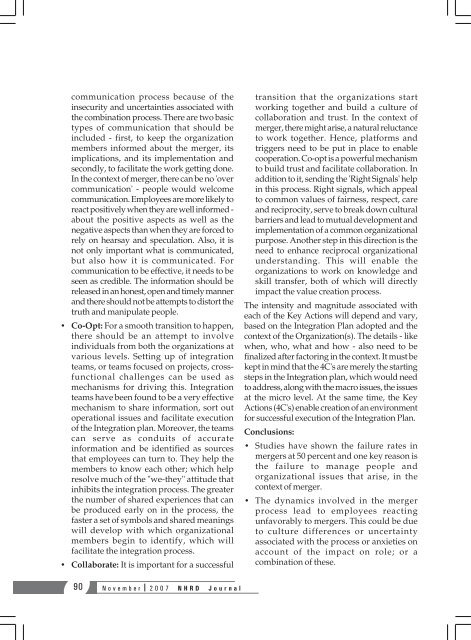NHRD Journal - National HRD Network
NHRD Journal - National HRD Network
NHRD Journal - National HRD Network
Create successful ePaper yourself
Turn your PDF publications into a flip-book with our unique Google optimized e-Paper software.
communication process because of the<br />
insecurity and uncertainties associated with<br />
the combination process. There are two basic<br />
types of communication that should be<br />
included - first, to keep the organization<br />
members informed about the merger, its<br />
implications, and its implementation and<br />
secondly, to facilitate the work getting done.<br />
In the context of merger, there can be no 'over<br />
communication' - people would welcome<br />
communication. Employees are more likely to<br />
react positively when they are well informed -<br />
about the positive aspects as well as the<br />
negative aspects than when they are forced to<br />
rely on hearsay and speculation. Also, it is<br />
not only important what is communicated,<br />
but also how it is communicated. For<br />
communication to be effective, it needs to be<br />
seen as credible. The information should be<br />
released in an honest, open and timely manner<br />
and there should not be attempts to distort the<br />
truth and manipulate people.<br />
• Co-Opt: For a smooth transition to happen,<br />
there should be an attempt to involve<br />
individuals from both the organizations at<br />
various levels. Setting up of integration<br />
teams, or teams focused on projects, crossfunctional<br />
challenges can be used as<br />
mechanisms for driving this. Integration<br />
teams have been found to be a very effective<br />
mechanism to share information, sort out<br />
operational issues and facilitate execution<br />
of the Integration plan. Moreover, the teams<br />
can serve as conduits of accurate<br />
information and be identified as sources<br />
that employees can turn to. They help the<br />
members to know each other; which help<br />
resolve much of the "we-they" attitude that<br />
inhibits the integration process. The greater<br />
the number of shared experiences that can<br />
be produced early on in the process, the<br />
faster a set of symbols and shared meanings<br />
will develop with which organizational<br />
members begin to identify, which will<br />
facilitate the integration process.<br />
• Collaborate: It is important for a successful<br />
transition that the organizations start<br />
working together and build a culture of<br />
collaboration and trust. In the context of<br />
merger, there might arise, a natural reluctance<br />
to work together. Hence, platforms and<br />
triggers need to be put in place to enable<br />
cooperation. Co-opt is a powerful mechanism<br />
to build trust and facilitate collaboration. In<br />
addition to it, sending the 'Right Signals' help<br />
in this process. Right signals, which appeal<br />
to common values of fairness, respect, care<br />
and reciprocity, serve to break down cultural<br />
barriers and lead to mutual development and<br />
implementation of a common organizational<br />
purpose. Another step in this direction is the<br />
need to enhance reciprocal organizational<br />
understanding. This will enable the<br />
organizations to work on knowledge and<br />
skill transfer, both of which will directly<br />
impact the value creation process.<br />
The intensity and magnitude associated with<br />
each of the Key Actions will depend and vary,<br />
based on the Integration Plan adopted and the<br />
context of the Organization(s). The details - like<br />
when, who, what and how - also need to be<br />
finalized after factoring in the context. It must be<br />
kept in mind that the 4C's are merely the starting<br />
steps in the Integration plan, which would need<br />
to address, along with the macro issues, the issues<br />
at the micro level. At the same time, the Key<br />
Actions (4C's) enable creation of an environment<br />
for successful execution of the Integration Plan.<br />
Conclusions:<br />
• Studies have shown the failure rates in<br />
mergers at 50 percent and one key reason is<br />
the failure to manage people and<br />
organizational issues that arise, in the<br />
context of merger.<br />
• The dynamics involved in the merger<br />
process lead to employees reacting<br />
unfavorably to mergers. This could be due<br />
to culture differences or uncertainty<br />
associated with the process or anxieties on<br />
account of the impact on role; or a<br />
combination of these.<br />
90<br />
November 2007 <strong>N<strong>HRD</strong></strong> <strong>Journal</strong>
















